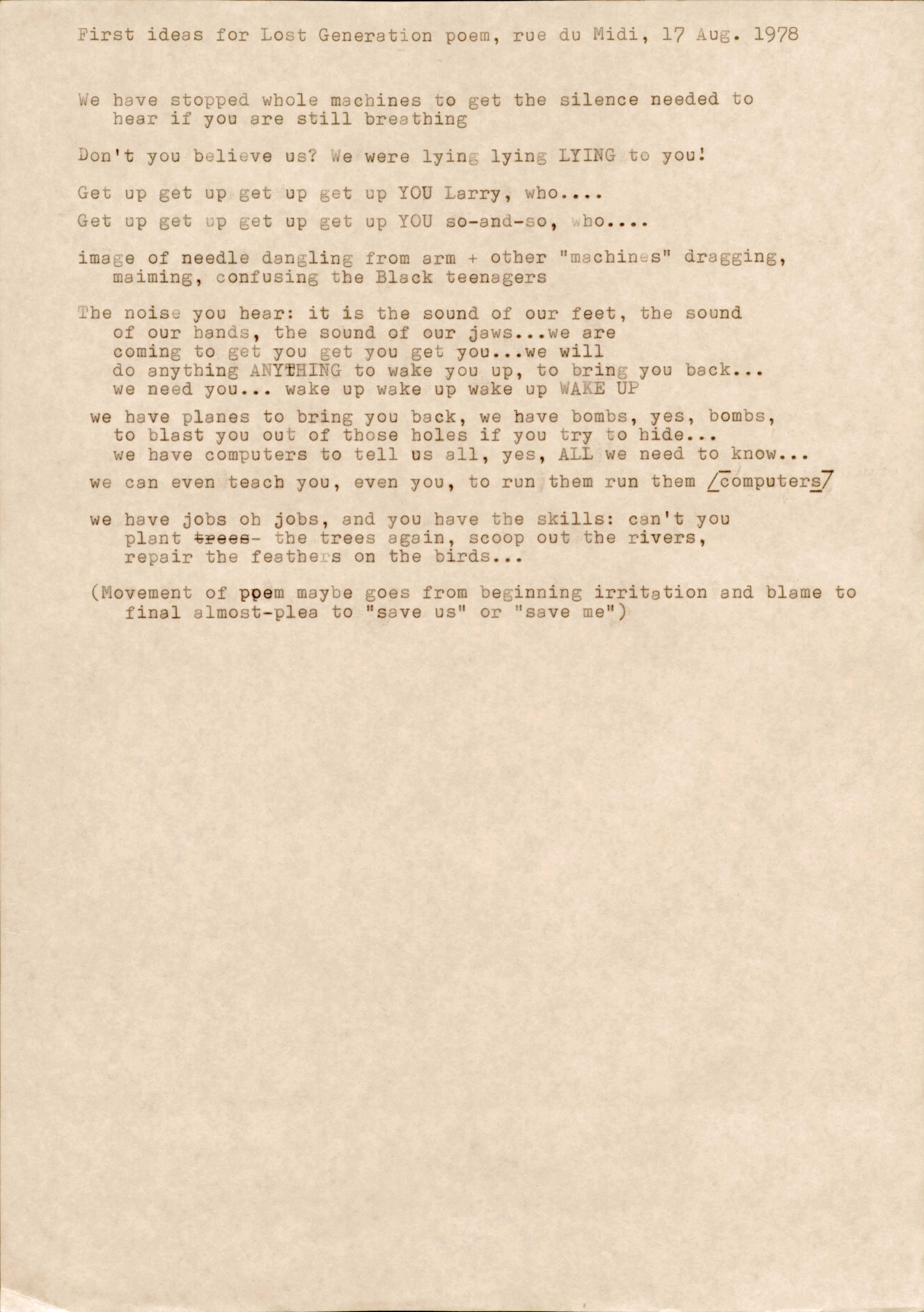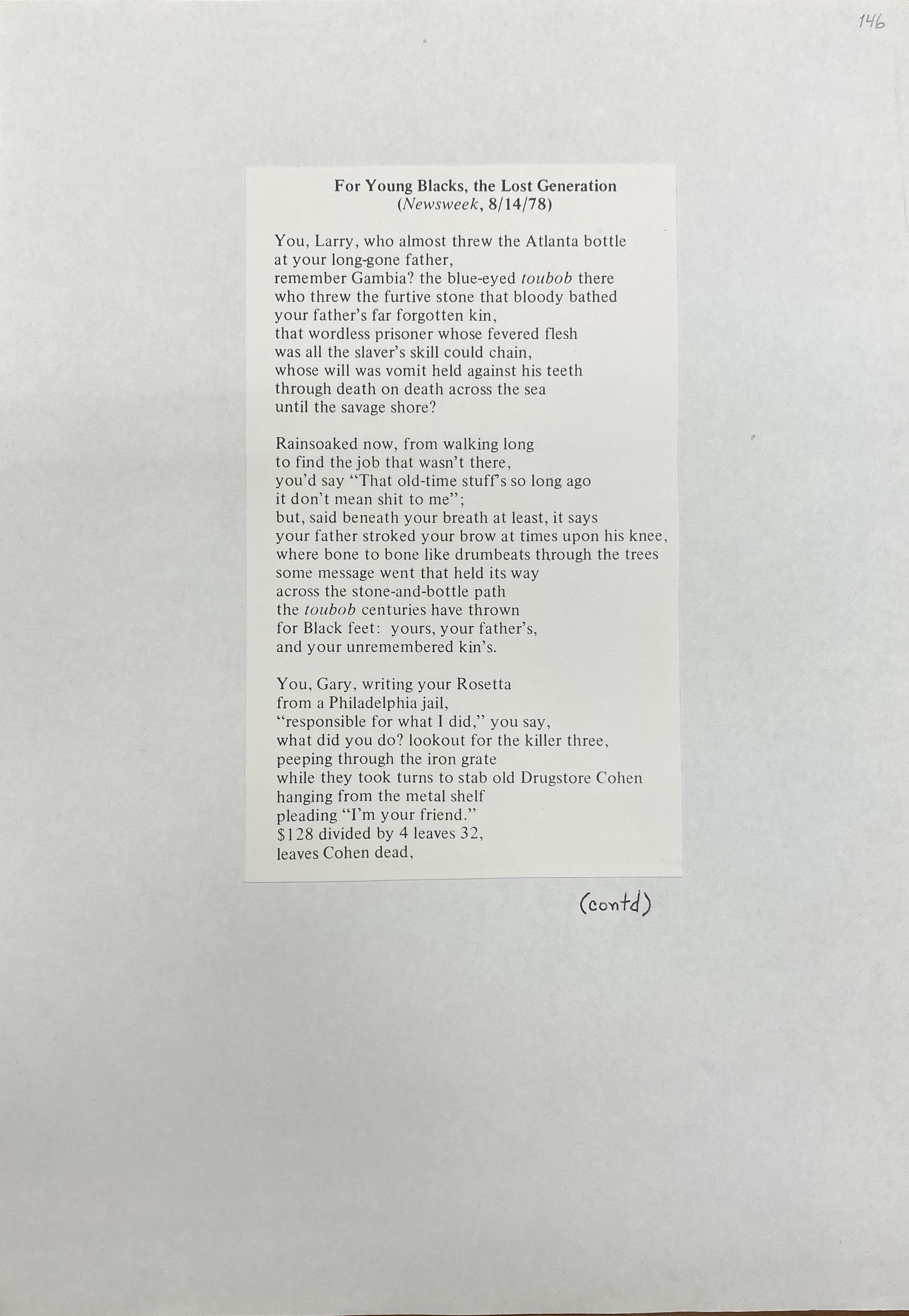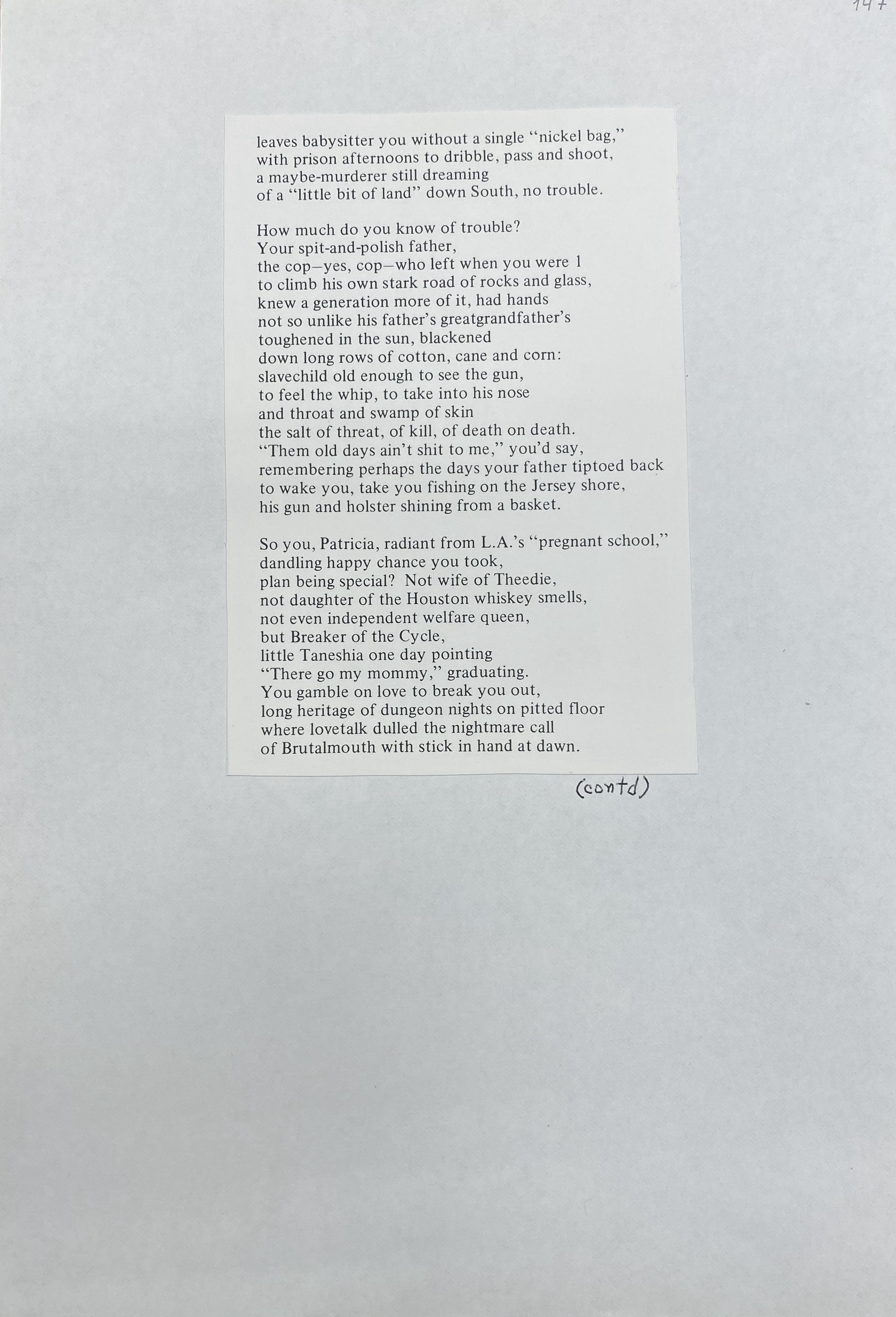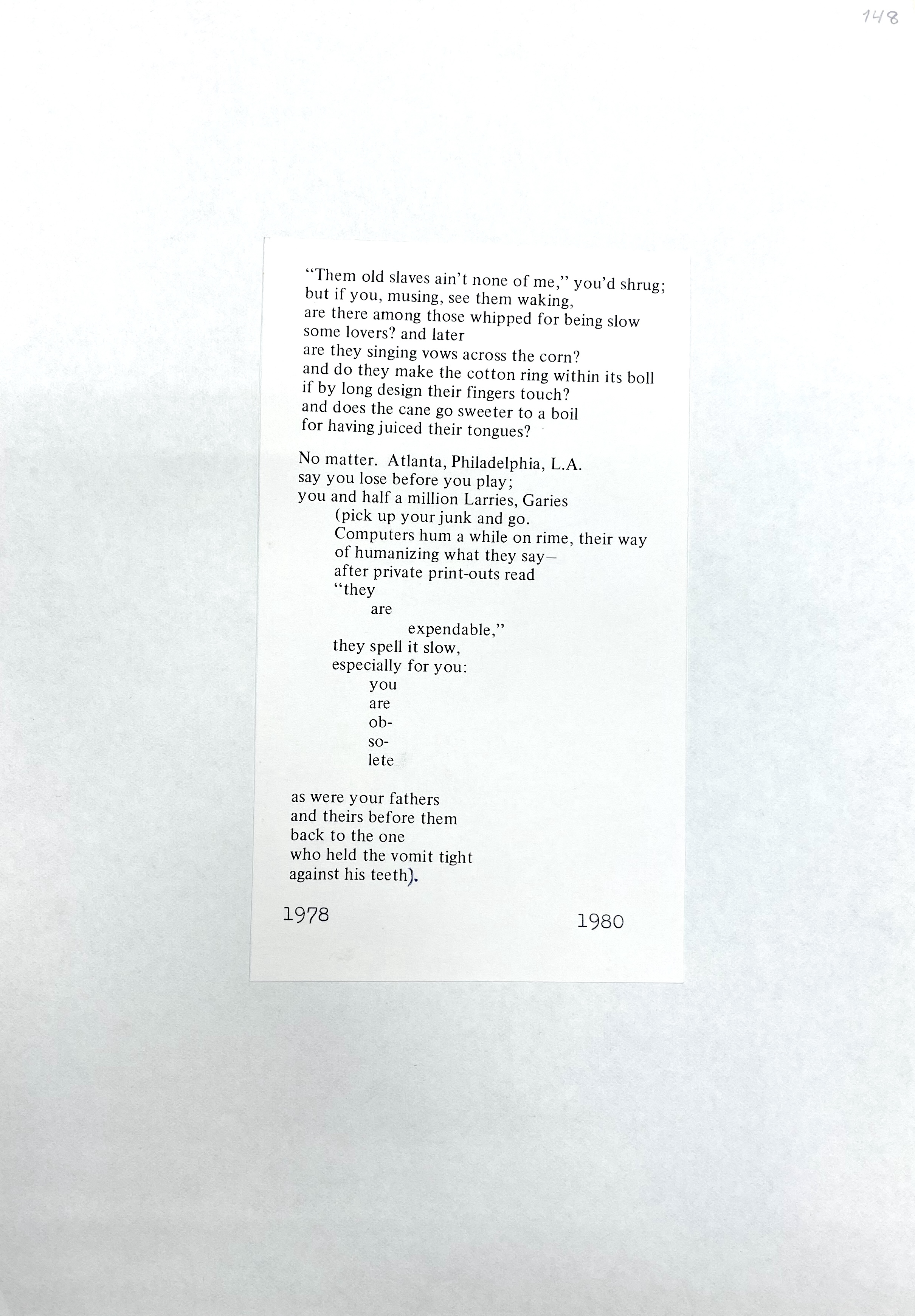Poem #3: “For Young Blacks, the Lost Generation (Newsweeek, 8/14/78)”
Prologue
Emanuel’s first draft of the poem initially titled “Lost Generation” consisted of nineteen lines across nine stanzas. He wrote into it with themes of resistance and survival through the use of repetition and a collective voice. In particular, the poem’s punctuation and repetition evoked the rhythmic chanting heard in Sonia Sanchez’s poetry. Sanchez describes her chanting as a practice that “calls up the history of Black chanters and simultaneously has the historical effect of old chants: it inspires action and harmony” (416). Emanuel’s first draft mirrors this intent. He writes:
The noise you hear: it is the sound of our feet, the sound
Of our hands, the sound of our jaws…we are
Coming to get you get you get you…we will
Do anything ANYTHING to wake you up, to bring you back…
We need you…wake up wake up wake up WAKE UP
This stanza fosters a sense of collective action and harmony. The repetition of “our” and “we” reinforce a shared identity and unites the speakers in their plea to the younger generation—the Lost Generation—to “wake up WAKE UP.” The chant serves as both a rhythmic and symbolic rallying cry that is in juxtaposition to the hums of modern technology, which are described as tools of distraction: “we have stopped whole machines to get the silence needed to hear if you are still breathing” (Emanuel “First Ideas” 1–2). The machines represent the encroachment of the information age and chants of the collective work as a direct and powerful counterforce to overstimulation without connection.

Figure 1. Draft Poem written by Emanuel in 1978 which captures feelings of disillusionment among Black teenagers due to industrialization and technological advancement.
After the last “WAKE UP,” the poem takes a desperate turn. The speakers, having silenced the machines, propose using technology to capture, expose, and surveil the lost generation in order to save them. This shift introduces a colonial undertone: The collective moves from resisting societal harms to imposing their own methods to control the youth. Lines like “we can even teach you, even you, to run them run them [computers]” highlight the disconnect between the youth and technological skills while simultaneously reaffirming negative societal stereotypes about their abilities (16).
However, the poem’s collective voice changes direction again in the final stanza. The speakers urge the lost generation to embrace skills aligned with environmental restoration, by proclaiming, “plant the trees again…scoop out the rivers, repair the feathers on the birds” (18). This call to action departs from technological solutions and embraces nature-focused tasks that challenge the machines’ dominance. By offering the youth a role in ecological restoration, the poem shifts its earlier colonial tone into one of empowerment that invites the lost generation to harmonize with their surroundings and adapt on their own terms. In this “First ideas” draft, the speaker's understanding of the lost generation shifts from action and harmony to radical desperation, which we could expect from a loved one who is seeking to find and affirm those they love. In the final draft, however, Emanuel homes in on ancestor acknowledgment.
Ancestor Acknowledgment
Emanuel began drafting the poem of “For Young Blacks” in London, and ten days later, it looked much like the final draft. This poem emphasizes the importance of ancestor acknowledgment in resisting oppressive conditions of a changing same. As indicated by the poem’s full title “For Young Blacks, the Lost Generation (Newsweek, 8/14/78),” the inspiration for the poem comes from the August 14, 1978 issue of Newsweek magazine. By incorporating this specific issue into the poem, Emanuel compels readers to consult the record to fully grasp the poem’s meaning. The poem is specifically inspired by the article “The New Negativism” by Vernon E. Jordan Jr., then president of the National Urban League. In his editorial, Jordan Jr. critiques what he terms a “mood of antisocial negativism” in the United States, which exacerbates the disadvantages faced by the poor and minority populations (13). Jordan Jr. provides evidence of this mood, including cuts to safety net programs, rising inflation and unemployment, challenges to affirmative action, and urban renewal policies. While Jordan Jr. aims to alert the broader American public to the societal fragmentation caused by these policies, Emanuel’s poem seeks to equip Black youth with the resilience to endure this era of “new negativism.” Emanuel’s use of ancestors in the poem illustrates how “the act of meditating on diaspora histories to learn tools of cultural survival presumes that we engage in temporal comparisons between oppressive conditions of the past, subsequent eras, and the present” (Temple 194). This poem makes the claim that without ancestors the lost generation are not fully equipped with tools of survival.

Figure 2. “For Young Blacks, the Lost Generation (Newsweek, 8/14/78)” (1 of 3).
In the first stanza, the speaker describes how Larry, must learn about the parallels between his life and the lives of his ancestors. He must hear the messages communicated to him by his father: “bone to bone like drumbeats through the trees” (17). Instead, Larry wants to distance himself from the past. He mutters “That old-time stuff’s so long ago/ it don’t mean shit to me” (Emanuel “For Young Blacks” 13–14). The “old-time stuff” refers to elusive employment and the centuries of hardship along the “stone-and-bottle path” (19). It is the same path that Larry, his father, and his “unremembered kin” have endured; it is a lineage that stretches across the Middle Passage to Gambia. Since Larry refuses to look back, his behavior aligns with that of a colonizer more than he’s aware. The Coke bottle Larry “almost threw” at his father is similar to the stone the “toubob” (which is a white person in Gambia) threw at his kin in Gambia. The speaker asks Larry to “remember Gambia,” so he understands that throwing the bottle is, in part, what creates the “stone-and-bottle path” that he must walk (3). Larry must use his ancestral memory as a tool for survival across generations and geographies.

Figure 3. “For Young Blacks, the Lost Generation (Newsweek, 8/14/78)” (2 of 3).
In the third and fourth stanzas, Gary must acknowledge the parallel between his troubles and the troubles of his ancestors. He is in a “Philadelphia jail” and admits he is “responsible” for acting as the lookout during a drugstore robbery and murder (25, 29, 31). While in jail, Gary dreams “of a ‘little bit of land’ down South, no trouble” (36). The speaker of the poem then asks him “How much do you know of trouble?” (37). The question connects Gary’s self-understanding to his cultural memory. This is done through imagery that superimposes Gary’s troubles onto those of his father, who “climb[s] his own stark road of rocks and glass,” (40) as well as his great-great-grandfather, who is depicted as a “slavechild old enough to see the gun/ to feel the whip” (45–46). Like Larry, Gary says “Them old days ain’t shit to me” (49). However, it is Gary’s memory of his father’s care that affirms him: “perhaps the days father tiptoed back/ to wake you, take you fishing on the Jersey shore/ his gun and holster shining from a basket” (50-52). Gary’s remembrance of his father’s protection and quality time undermines his rejection of the past and affirms his need for ancestral connection.

Figure 3. “For Young Blacks, the Lost Generation (Newsweek, 8/14/78)” (3 of 3).
The final youth in this lost generation poem is Patricia, who, without historical awareness, attempts to separate herself from her heritage. She attends L.A.’s “pregnant school” and “gamble[s] on love to break [her] out” (53, 61). The speaker asks Patricia if her plan is special and offers her a chance to learn her heritage in order to envision a future unbound by dependency (55). This future is depicted through Patricia being the “Breaker of the Cycle, / little Taneshia one day pointing / ‘There go my mommy,’ graduating” (58–60). The speaker conveys that Patricia "being special" lies in acknowledging the struggles of her ancestors, learning from them, and breaking generational cycles. However, similar to Larry and Gary, Patricia asserts, “Them old slaves ain’t none of me” in order to distance herself from the history of Black struggle (65). Yet the speaker invites her to visualize her enslaved ancestors waking, then asks: "Are there among those whipped for being slow / some lovers?" (67–68). Beautifully written, this question shows how the punishment Patricia experiences due to her pregnancy is similar to those of her ancestors. Her placement in a separate school (53) and the political stereotypes of her being a teenage, unwed mother (55), and an “independent welfare queen” (57) are akin to her ancestors being punished for allowing love to slow their participation in capitalistic production on the plantation. Though the speaker does not critique a society that engineers such options, the poem shows that without ancestral acknowledgment Patricia will make similar errors.
This final section of the poem establishes how these Black youth represent a type of every (wo)man of the lost generation: “No matter. Atlanta, Philadelphia, L.A. […] you and half a million Larries, Garries” (74, 76). The poem then returns to the technological images that appear in Emanuel’s first draft. In this part of the poem the voice shifts from the original speaker to computers speaking within the parentheses. The passage opens “pick up your junk and go” (77). The “computers hum” and the “private print-outs read” (78, 80): “they / are / expendable” (81–3). This is connected to the future (88–90)—the computers are now the laborers: the "Computers hum a while on rime, their way / of humanizing what they say (98–9). To combat this, Emanuel offers ancestor acknowledgment, as a way, to provide tools of reflection, resistance, and survival through cultural memory.
Works Cited
Emanuel, James A. “First Ideas for LOST GENERATION.” From “Chisel in the Dark,” Draft, n.d. Version 8/17/1978. James A. Emanuel papers, 1922 - 2018. Library of Congress, Washington, D.C. MS Box 4, Folder 22.
Emanuel, James A. “For Young Blacks, the Lost Generation (Newsweek, 8/14/78).” From “The Chopping Block (Selected Poems),” Draft, 1988 (2 of 2), Final Version. James A. Emanuel papers, 1922 - 2018. Library of Congress, Washington, D.C. MS Box 4, Folder 27.
Jordan Jr., Vernon E., “The New Negativism.” Newsweek, 14 Aug. 1978, p. 13.
Sanchez, Sonia. “Ruminations/Reflections (1984).” I’m Black When I’m Singing, I’m Blue When I Ain’t and Other Plays, edited by Jacqueline Wood, Duke University Press, 2010, pp. 15–18. https://doi.org/10.1515/9780822393054-004.
Temple, Christel N. “Richard Wright’s Navigation of the Antihero.” Black Cultural Mythology, State University of New York Press, 2020. pp. 183–98. https://www.jstor.org/stable/jj.18253021.11.